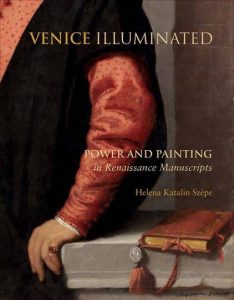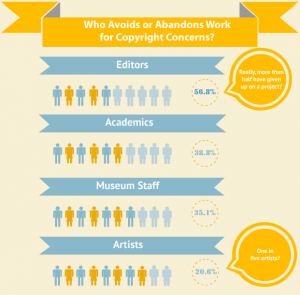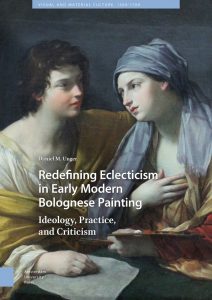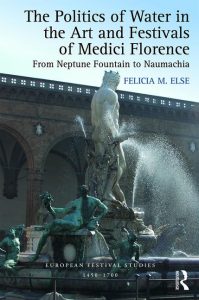CAA News Today
News from the Art and Academic Worlds
posted May 27, 2020
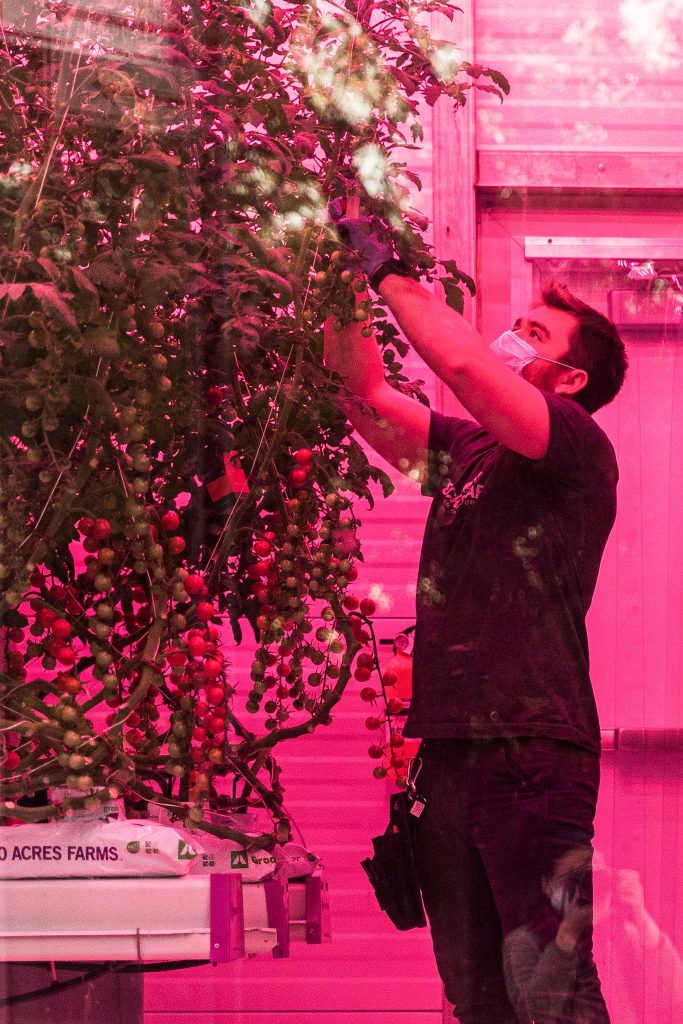
David Litvin checks the tomatoes growing outside the Guggenheim Museum, where he is one of the few people who show up each day for work. Credit: Jeenah Moon for The New York Times
|
|
|
|
|
Want articles like these in your inbox? Sign up for our weekly newsletter:
New in caa.reviews
posted May 22, 2020
Debra Pincus writes about Venice Illuminated: Power and Painting in Renaissance Manuscripts by Helena Katalin Szépe. Read the full review at caa.reviews.
News from the Art and Academic Worlds
posted May 20, 2020
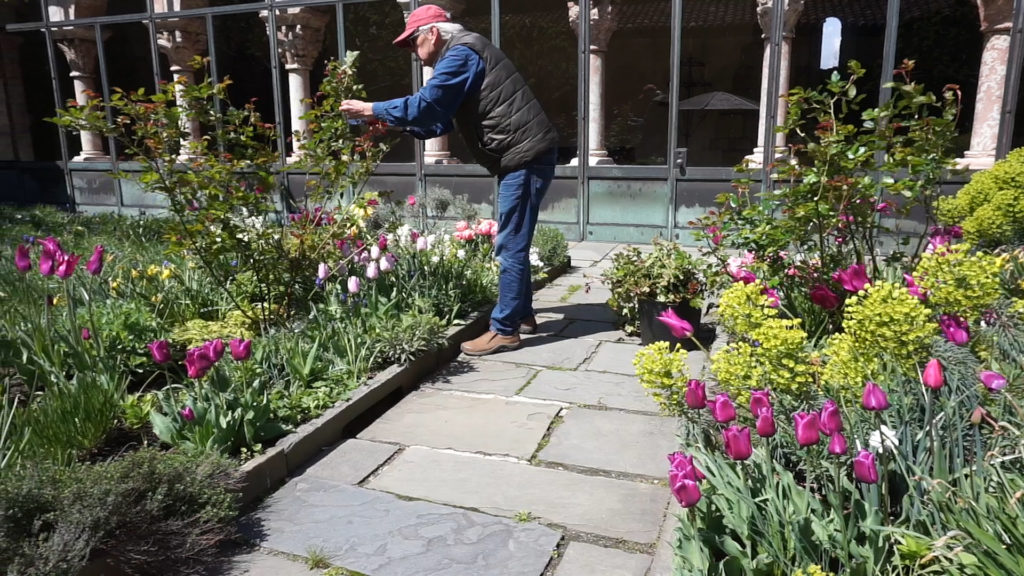
The managing horticulturist at the Met Cloisters, Marc Montefusco. Photo courtesy of Marc Montefusco, via artnet News
|
|
|
|
|
Want articles like these in your inbox? Sign up for our weekly newsletter:
An Interview with Suzanne Preston Blier on CAA’s Code of Best Practices and Publishing with Fair Use
posted May 19, 2020
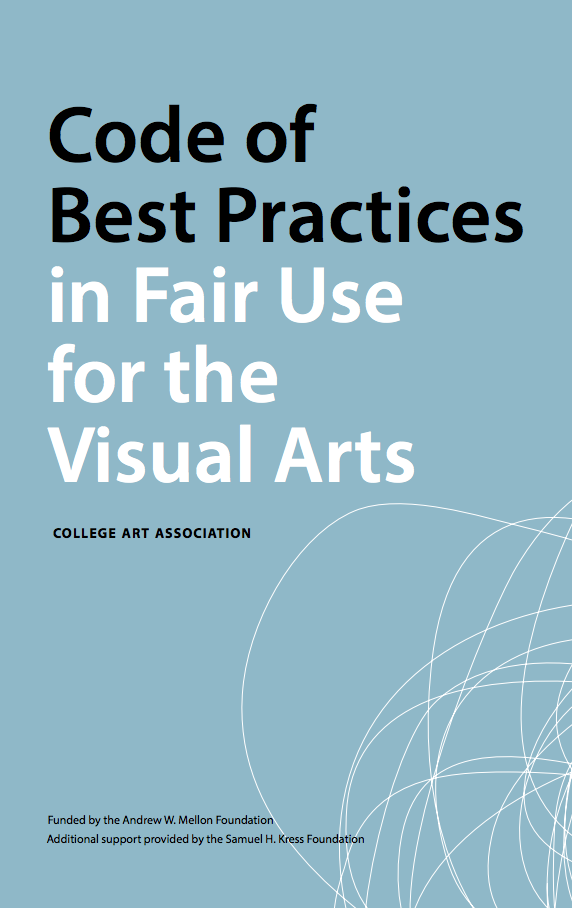 In 2019, Suzanne Preston Blier, professor of African art at Harvard University and former president of CAA, published a major book on Picasso’s use of global imagery, Picasso’s Demoiselles: The Untold Origins of a Modern Masterpiece. In addition to its scholarship the book is groundbreaking for its reliance on fair use, the principle within US copyright law that permits free reproduction of copyrighted images under certain conditions. CAA led the way among visual arts groups in calling for reliance on fair use, producing in 2015 its Code of Best Practices in Fair Use for the Visual Arts.
In 2019, Suzanne Preston Blier, professor of African art at Harvard University and former president of CAA, published a major book on Picasso’s use of global imagery, Picasso’s Demoiselles: The Untold Origins of a Modern Masterpiece. In addition to its scholarship the book is groundbreaking for its reliance on fair use, the principle within US copyright law that permits free reproduction of copyrighted images under certain conditions. CAA led the way among visual arts groups in calling for reliance on fair use, producing in 2015 its Code of Best Practices in Fair Use for the Visual Arts.
In this interview with Patricia Aufderheide, university professor and founding director of the Center for Media & Social Impact (CMSI) at American University, and a principal investigator in the CAA fair use project, Blier relates how she became an inadvertent pioneer of fair use in art history.
An Interview with Suzanne Preston Blier, Harvard University
By Patricia Aufderheide, American University
I met Prof. Blier, an award-winning art historian, when CMSI joined others in facilitating the Code of Best Practices in Fair Use for the Visual Arts for the College Art Association (CAA), with funding from the Samuel H. Kress and Andrew W. Mellon Foundations. Fair use is the well-established US right to use copyrighted material for free, if you are using that material for a different purpose (such as academic analysis, for instance) and in amounts relevant to the new purpose. Blier was the incoming president, as the Code launched.
The project addressed a huge need. Art historians, visual artists, art journal and book editors, and museum staff all have faced major hurdles in accomplishing their work because of copyright. Art historians avoided contemporary art in favor of analyzing public domain material. Visual artists hesitated to undertake innovative projects that reuse existing cultural material. Editors, or sometimes their authors, faced monumental bills for permissions and sometimes those permissions depended on an artist or artist’s estate agreeing with what they say. Museums hesitated to do virtual tours, or use images in their informational brochures, or even to mount group exhibits, because of prohibitive permissions costs. All together, some people in the visual arts called this “permissions culture.”
Once the Code came out, some things changed immediately. Museums rewrote their copyright use policies. Artists made new work. CAA’s publications—some of the leading journals in the field—adopted fair use as a default choice.Yale University Press prepared new author guidelines for fair use of images in scholarly art monographs to encourage fair use. Blier was one of the Code’s champions.
And then she needed it herself. As she began work on her most recent book, which ultimately resulted in Picasso’s Demoiselles: The Untold Origins of a Modern Masterpiece (Duke University Press, 2019, winner of the 2020 Robert Motherwell Book prize for an outstanding publication in the history and criticism of modernism in the arts by the Dedalus Foundation), she realized the subject faced the stiffest possible copyright challenge. To tell her story, she would have to be able to show images from a variety of artists, most challengingly, Picasso. She thought of Duke University Press, a publisher that has been willing to go ahead of others on fair use. So Blier approached them. Duke was very supportive, and they ended up hiring extra legal counsel for this. In the end, Blier said, she had to rewrite certain sections, and redo some images at the suggestion of outside counsel, to strengthen the fair use argument.
Blier tells the story of how the book got out into the world (and won an award), below.
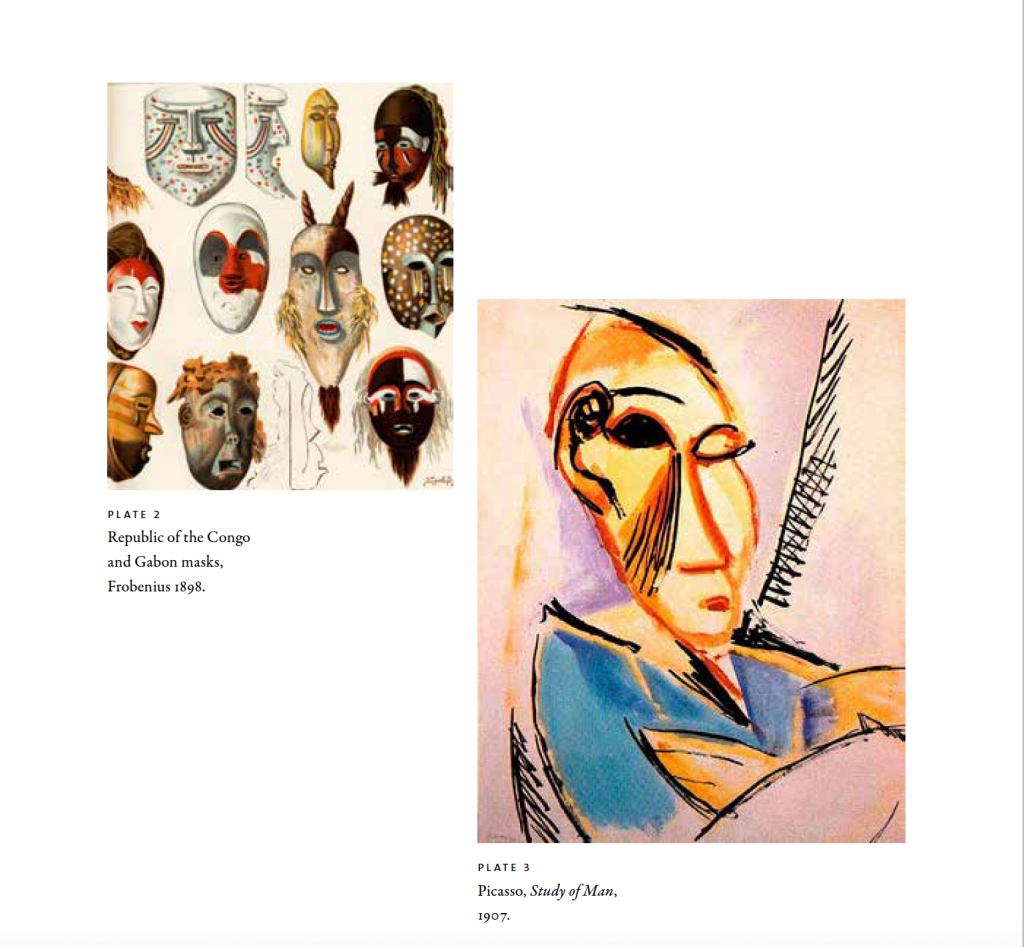
Figure 1. Congo masks published in Leo Frobenius’ 1898 Die Masken und Geheimbünde Afrikas alongside Pablo Picasso’s Study of Man (1907). The Congo mask at the bottom, second from the left is the likely source for the crouching demoiselle. The mask at the top left shows tear lines from the eyes crossing diagonally down the cheeks similar to Picasso’s preliminary study for one of the men in an early compositional drawings for the canvas.
You’re an expert in African art. How did you end up writing a book about one of the most famous modernist artists?
This is a book I never intended to write; it found me. For my previous book, Art and Risk in Ancient Yoruba: Ife History, Power, and Identity, I was doing those last-minute bits of work in the library to check sources, and I pulled out a book adjacent to the book I was looking for, an old book by the German anthropologist, Leo Frobenius. I hadn’t read it since graduate school. As I opened it up, I looked down and I said, Wow, this is a book on African masks and they look like they’d be the ones Picasso used as models for his famous 1907 painting Demoiselles d’Avignon. At the time I had first read the book, Picasso’s drawings for the painting hadn’t been released. This time I saw it differently and as I was looking at it in the library, I saw there was tracing paper over the pictures. There was a line drawing covering each mask, and that seemed significant too.
The next thing I knew, I was hunting for a book from the Harvard library on Dahomey women warriors. It turned out it was in the medical school library, which should have been a sign. When I picked it up at the main library and flipped it open, I thought, Oh my god, it’s pornography! It was photos and line drawings of women around the world, in supposed “evolutionary” order. Photos of naked women begin with so-called “archaic,” in Papua New Guinea, right through to southern Europe, then Denmark. In the library I’m bending over, kind of hiding it, out of embarrassment. I bring it home and realize, Ohhhh! Here’s another key source for Demoiselles. This volume, which was by Karl Heinrich Stratz, had gone through multiple editions, and one was published about the same time Picasso stopped using living models. Then I found another book, by Richard Burton, which had a rendering that Picasso clearly used for his 1905 sketch Salomé.
What happened next was the clincher. I went to Paris to lecture at Collège de France. The week before my lectures, I went to hear another speaker at the Collège, a medieval historian. One of the first slides he presented was a work from a medieval illustrator, Villard De Honnecourt. This book was a modern edition of an illustrated medieval manuscript, published in the right time frame for Picasso to have seen it. And I thought, Well, here’s another source Picasso used.
Later I was also able to rediscover a photo that allowed me to date the painting to a single night in March 1907. The scene is often identified as a brothel, but bordel in French doesn’t mean bordello, but rather a chaotic or complex situation. It was my belief that Picasso was creating a time-machine kind of image of the mothers of five races, as he understood them from the Stratz ethno-pornography book and other sources, each depicted in the art style of that region or period. My larger argument is not only that Picasso was using book illustration sources, but also that these books invite us to see the canvas in a new light, and that, for Picasso, the painting has its intellectual grounding in colonial-era ideas about human and artistic evolution.
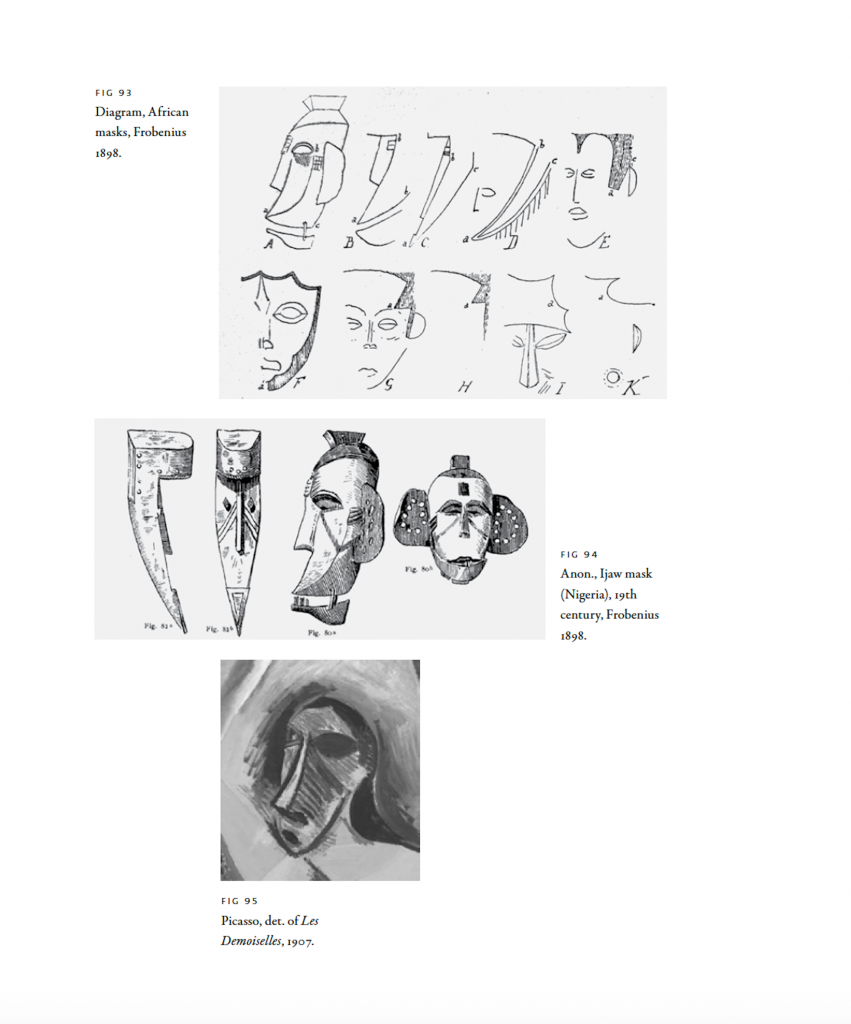
Figure 2. Illustrations from Leo Frobenius’ 1898 Die Masken und Geheimbünde Afrikas showing (top two rows) the visual development of a mask into a human face. The middle illustration ,from the same Frobenius book shows line drawings of ijaw masks from Nigeria. The bottom image is a detail of the standing African figure from Picasso’s 1907, Les Demoiselles d’Avignon which appears to be based on a combination of these two masks.
What a sleuthing job! And so you decided to write the book then?
I wrote the first two chapters while I was in Paris doing the lecture. I saw it not as a coffee-table art book, but the kind of book you put in your knapsack as you head off to a long ride on the subway.
It was easy to write, but it was a very different story for the images. I immediately got a trade publisher in Britain to agree to publish it, and then they said they could not do it, because of problems getting permission to reproduce images from the Picasso Foundation.
The Picasso Foundation is notorious for making it difficult to access Picasso images, isn’t it?
The price of permissions is high, and this Foundation like many estates is interested in guarding the artist’s reputation as well. The difficulties of publishing on Picasso have been manifested in how little publishing was being done, and how scarce the images were in that work. Since 1973, there have been few heavily illustrated books about Picasso, except by wealthy individuals or museums in relation to an exhibition. I had heard about Rosalind Krauss publishing a work without permissions—at least that’s what I heard—anyway, she used very few images. Leo Steinberg apparently had not been able to arrange the rights for a work he wanted to do, a book edition of his two seminal articles on Les Demoiselles.
Although I hadn’t realized it until recently, in September 2019 there was an important case in the US, about a set of illustrated books by Christian Zervos with a wide array of Picasso illustrations. The case was started in France, but a US judge has allowed fair use.
But generally, yes, there’s common wisdom among art historians that the Picasso Foundation is a formidable challenge.
So how did you proceed when the first publisher backed out?
I was disheartened, but I got an agent. He sent it off to ten or twelve trade publishers worldwide—and came up with nothing.
Then I realized I was going to have to go to a university press. That was a big decision. The trade publication will pay for the images, and do all the work on the rights clearance. But with a university press, you’re on your own.
One of the first people I contacted was legendary editor Ken Wissoker at Duke University Press. He was interested, but then came the issue of the images. I may have broached fair use with him from the start. The manuscript had gone through peer review and it was in great shape except for this copyright issue. I had quite a number of images—in the end, it was 338. At Duke, they won’t begin the editorial process until you have all the copyright clearances on images done. So I began the difficult process of deciding how to get the images.
Were you in contact with the Picasso Foundation directly?
I did contact them, in order to let them know about the project in general. I was doing final research work in Paris. I had framed the book as a travelogue in part addressing my discovery of these sources. I also wanted to find out so much more about Picasso. I’m not a modernist, I’m an outsider to the field. So I worked hard to get as much insight and criticism of the manuscript from specialists as I could.
I made it a point to meet with people at the Picasso Foundation. I had a Powerpoint of the images, which I showed to one of the key people there. Later I wrote to them, “here’s the manuscript, let me know if you have any thoughts.” And I heard nothing back. I had heard that with some manuscripts, they have been concerned one way or another. I didn’t want their permission for the intellectual content, but since they knew this artist and his life and family better than any academic could, I wanted their insights.
And then you started to look for permissions?
Well, I began to think about the cost of acquiring the images. The process is such that you have to go through the Artists Rights Society (ARS, a US licensing broker). And to get a price, you have to furnish the number of images, how many are color, the size of the print run, the prospective profit, and a whole series of things we could not know. Duke wouldn’t even look at the project editorially without having the rights in hand. I had heard difficult stories—that they were interested in looking at the galleys along the way, and requesting changes, for quality control, but it wasn’t possible to do this and work with the press.
If I had to guess, I would say that it might have cost me something like $80,000 of my own money to purchase the minimum number of images for this scholarly book, from which I expect to make no money, or very little.
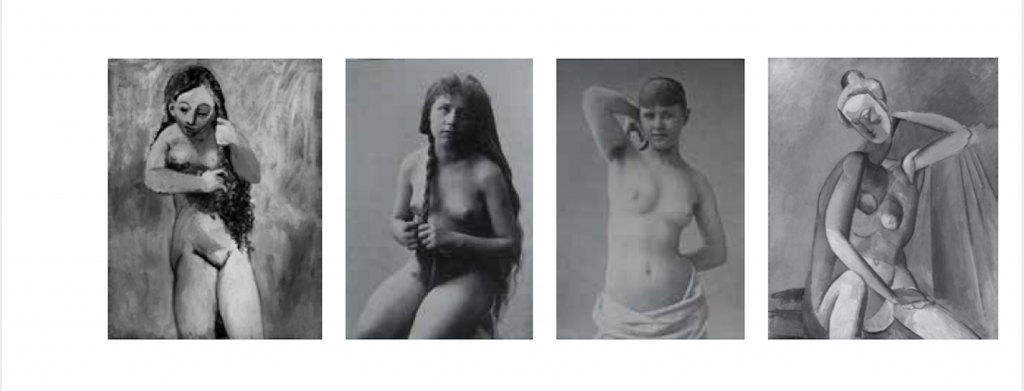
Figure 3 from left to right: Pablo Picasso, Nude Combing Her Hair, 1906; Girl braiding hair from C. H. Stratz, La beauté de la femme, 1900 (Paris); Girl from Vienna from C.H. Stratz, La beauté de la femme, 1900; Picasso Seated Female Nude, 1908. Over the course of his long career Picasso would continue to use key visual insights from Frobenius, Stratz, and other illustrated sources he was exploring in this late 1906 to early 1907 period.
So how did you come to the decision to use them under fair use?
I had been president of CAA in 2016-17, and a longtime promoter of fair use and IP issues more generally. I was involved in the creation of the Code of Best Practices in Fair Use for the Visual Arts. For me, CAA’s role in fair use is one of the most important and radical (in a positive way) things that it has ever done.
I decided that fair use would make the most sense in this context. This was a book about an important modern artist. In addition, I’m a senior scholar—this was not my first publication. If the worst happened, if I had problems, well, I’ve had a great career and this would not harm it. I have tenure and so on. Also, as the then-president of CAA, I thought it was important to do this.
Besides, this to me was part of a larger picture of what I had done in my larger career. I’m very active locally in civic affairs, and really interested in promoting transparency, and democratic ideals. I was also very fortunate to have Peter Jaszi, a foremost legal scholar on fair use (and another principal investigator on the CAA project), working with me. At his suggestion, I took out an insurance policy, which for a fee—I think about $5,000—(with a $10,000 deductible) I was able to lower my anxiety level. I also paid $400 for an attorney to look over the insurance contract. And I had good friends like you, who when I got cold feet assured me it was the right thing to do. And of course, Duke is a publisher that has been willing to go ahead of others on fair use.
Can you give me an example of something you had to change in the text to strengthen the fair use argument?
With a museum photograph of an African mask, for example, I had to explain why this particular way of photographing the work was critical to the argument in my book. I had to ad a few sentences to justify my selection of several Picasso works as well. I also had to give reasons in my text for why each of the chapter epigraphs was necessary.
Did you have to alter the use of imagery in any way to accommodate fair use?
There are changes the press made, design-wise, that reflected in part the decision to employ fair use. Many of the photos are shown in black-and-white and the majority are reduced in size. I was constrained by the fact that I could only employ fair use if I could get access to the materials without going through the Picasso Foundation. So I had to acquire nearly all the images from published books, and many of the Picasso images were published in black and white and at a very small size, in a grainy context. I had to spend a lot of time hunting down the best possible images to use. In my book they are shown in relatively small size, along with information on where you can find color versions online.
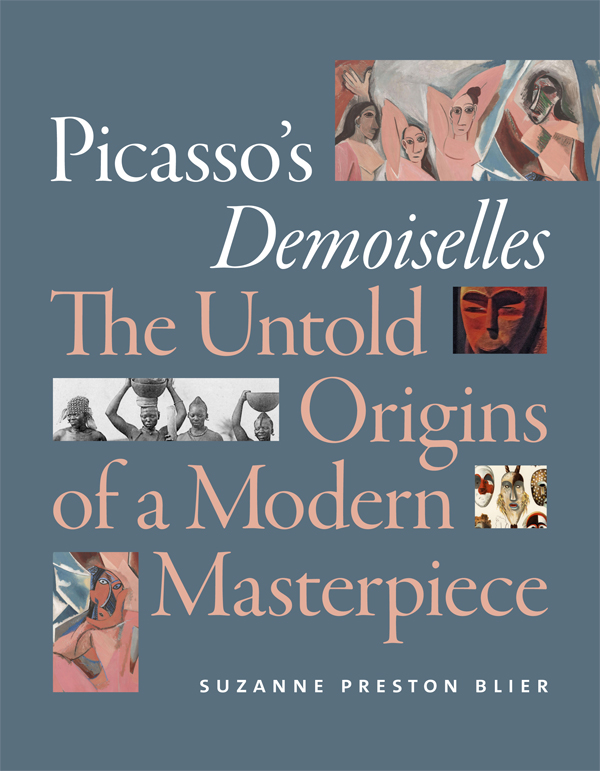
That didn’t bother me too much, though. For readers and viewers at this juncture in the Internet era, we have become expert at extrapolating the fuller figure from a small image.
There is also a small spread of color images, a couple Picasso works as well as from other artists. For these images color was central to the book.
The decision to publish largely in black-and-white was, I think, also related to the fact that the Picasso Foundation and others are concerned that color representations be incredibly accurate, and it is very hard to get the color exactly right, when copying from books. You also have an issue with paper quality in getting accurate representation.
The cover is a handsome design, and very clever. They broke up the images into thumbnail-like sections, requiring you as a viewer to put them together as one image, similar to how Picasso was thinking in the early stages of cubism, where you as a viewer of an assemblage have to assemble them in your own mind, to make it work for you as a whole.
How was the book received?
It was a finalist for the Prose Prize, a prize of publishers to authors. My previous book won it in 2016. I didn’t expect to win it this time again, in 2019. I was very honored that it was a finalist. It was also featured in the Wall Street Journal’s holiday art book list. And then, just recently, it won the Robert Motherwell Book Award.
Has the Picasso Foundation seen the book?
To date I’ve heard nothing. I was thinking earlier that the Picasso Foundation might want to stop it pre-publication. So much so that when I came back from travel in Africa, I went first to my academic mailbox, and was relieved when I saw no big legal envelope. But there has been no pushback. I certainly gave them the opportunity to comment on the content while it was still in manuscript. And last April or May, I went to France to meet with the curators at Musée Picasso about contributing an essay to a catalog. I sent them an article draft which they decided not to publish, which is fine, but also sent them a copy of the manuscript, and of course the Musée speaks to the Foundation.
Interestingly, the two cases where the Foundation has sued or prevented publication that I know of have to do with children’s books about Picasso. I don’t know what that means.
Does the wider art history community know about this?
I hope this personal story makes a difference. We still have a lot of educating to do, in spite of the work we did around the Code. I continually get, on the art history listservs, questions—How can I get permission, and I always say, Use fair use. People still don’t trust it or believe it’s more difficult than it is.
At the CAA conference I just went to in Chicago, there seems to be a division between presses. Presses at private universities–Yale, Princeton, MIT, Duke—seem to feel more comfortable exploring this. But for university presses at some public institutions, these legal issues have to be taken up with the state attorney general, and there can be real nervousness stepping outside a narrow parameter. I learned this speaking to an editor at a state university press in a progressive state, who believes they’re being held back because of this fear.
I was pleased to see at this same conference a pamphlet on fair use by Duke University Press’s former Director, Steve Cohn. In his essay, he mentions my Picasso book and how happy he is that Duke chose to publish it this way. I figured, if Steve is openly talking about this fair use project, then the proverbial cat is out of the bag, and I could be more open and provide some of the back story from my end.
CAA’s scholarly publications, The Art Bulletin, Art Journal, and Art Journal Open rely on fair use as a matter of policy, and indicate when they do so in their photo credits. View a complete discussion of fair use and CAA’s Code of Best Practices.
New in caa.reviews
posted May 15, 2020
Lorenzo Pericolo discusses Redefining Eclecticism in Early Modern Bolognese Painting: Ideology, Practice, and Criticism by Daniel M. Unger. Read the full review at caa.reviews.
News from the Art and Academic Worlds
posted May 13, 2020
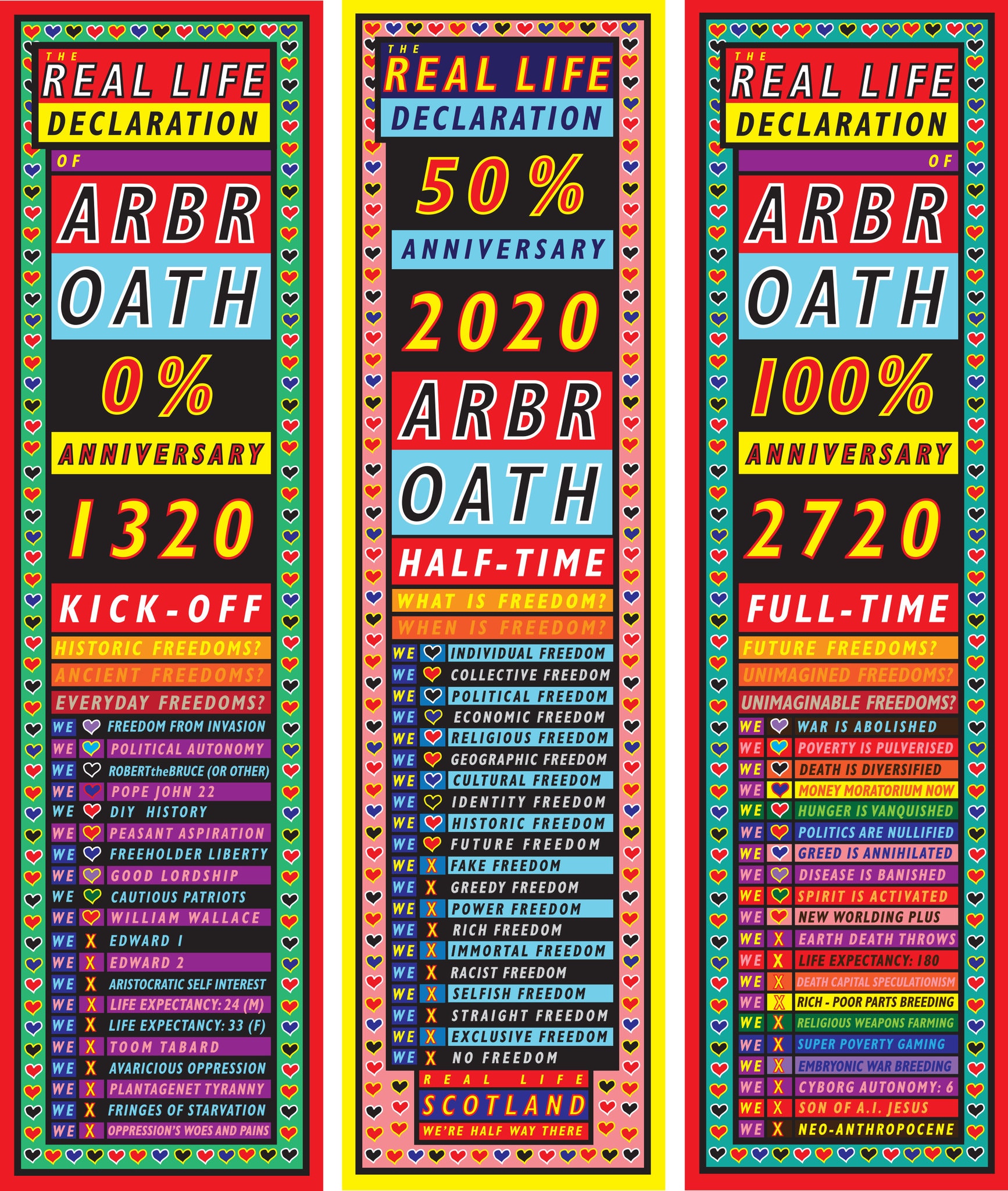
Ross Sinclair’s The Real Life Declaration of Arbroath 1320–2720, 2020, one of the works in the Royal Scottish Academy’s annual exhibition, which went entirely online because of the pandemic. Image: Royal Scottish Academy, via New York Times
|
Want articles like these in your inbox? Sign up for our weekly newsletter:
Announcing the 2020 Recipients of the Art History Fund for Travel to Special Exhibitions
posted May 12, 2020
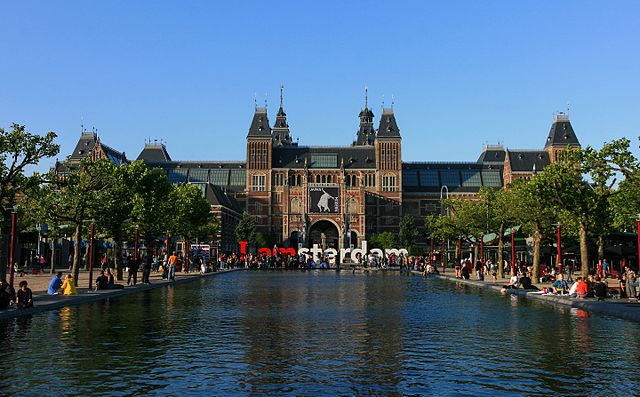
Rijksmuseum, Amsterdam
In fall 2018, we announced CAA had received an anonymous gift of $1 million to fund travel for art history faculty and their students to special exhibitions related to their classwork. The generous gift established the Art History Fund for Travel to Special Exhibitions.
The jury for the Art History Fund for Travel to Special Exhibitions has now selected the second group of recipients as part of the gift. This year’s awardees are:
Holly Flora, Tulane University, New Orleans, LA
Course: Art, Cosmopolitanism, and Intellectual Culture in the Middle Ages
Exhibition: Medieval Bologna: Art for a University City at the Frist Center for the Visual Arts, Nashville, TN
Caroline Fowler, Clark Art Institute, Williamstown, MA
Course: Slavery and the Dutch Golden Age
Exhibition: Slavery at the Rijksmuseum, Amsterdam
Maile Hutterer, University of Oregon, Eugene, OR
Course: Time in Medieval Art and Architecture
Exhibition: Transcending Time: The Medieval Book of Hours at The Getty Center, Los Angeles, CA
Erin McCutcheon, Lycoming College, Williamsport, PA
Course: Art & Politics in Latin America
Exhibition: Rafael Lozano-Hemmer: Unstable Presence at SFMOMA, San Francisco, CA
Shalon Parker, Gonzaga University, Spokane, WA
Course: Women Artists
Exhibition: New Time: Art and Feminisms in the 21st Century at the Berkeley Art Museum and Pacific Film Archive, Berkeley, CA
Rebecca Pelchar, SUNY Adirondack, Queensbury, NY
Course: Introduction to Museum Studies
Exhibition: Marcel Duchamp: The Barbara and Aaron Levine Collection at the Hirshhorn Museum, Washington, DC
As museums and schools have moved online in light of the coronavirus pandemic, we are being as flexible as necessary with the dates of travel to accommodate all award winners and classes.
The Art History Fund for Travel to Special Exhibitions supports travel, lodging, and research efforts by art history students and faculty in conjunction with special museum exhibitions in the United States and throughout the world. Awards are made exclusively to support travel to exhibitions that directly correspond to the class content, and exhibitions on all artists, periods, and areas of art history are eligible.
Applications for the third round of grants will be accepted by CAA beginning in fall 2020. Deadlines and details can be found on the Travel Grants page.
New in caa.reviews
posted May 08, 2020
Fernando Loffredo reviews The Politics of Water in the Art and Festivals of Medici Florence: From Neptune Fountain to Naumachia by Felicia M. Else. Read the full review at caa.reviews.
Affiliated Society News for May 2020
posted May 07, 2020
Affiliated Society News shares the new and exciting things CAA’s affiliated organizations are working on including activities, awards, publications, conferences, and exhibitions.
Interested in becoming an Affiliated Society? Learn more here.
Women’s Caucus for Art (WCA)
Historians of Netherlandish Art (HNA)
Call for Session Proposals for HNA Sponsored panel at CAA 2021:
HNA is seeking submissions for our sponsored panel at the College Art Association’s annual conference, which will be held February 10-13th, 2021, in New York City.
Proposals should address the session description:
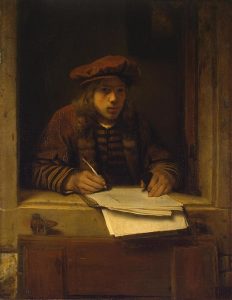
Samuel Dirksz van Hoogstraten, Self-portrait, late 1640s/1650, via Wikimedia Commons
Published in 1678, Samuel van Hoogstraten’s painting treatise, Inleyding tot de hooge schoole der schilderkonst, anders de zichtbaere wereld (Introduction to the Academy of Painting, or the Visible World), is simultaneously a pedagogical guide and a theoretical treatise on art, grounded in the painter’s practical knowledge. Written in the vernacular for an audience of Dutch artists, as well as collectors, connoisseurs, amateurs and lovers of art, Hoogstraten’s text has been mined by art historians for its conceptual vocabulary, classical referents, theories of optics and vision, and for its salacious anecdotes about Hoogstraten’s famous teacher, Rembrandt. This session seeks papers addressing the key themes of this heterogeneous text, and/or the multi-faceted career of its author, in honor of the 2020 publication of the first English translation of van Hoogstraten’s work by Celeste Brusati. Beyond the writings of van Hoogstraten, papers may address broader questions of artistic pedagogy and travel, artists’ writings, material knowledge and embodied practice, imitation and aesthetic judgment in the early modern Low Countries.
Please send proposals (ca. 250 words) and CVs to sporras@tulane.edu by May 10.
Association of Print Scholars (APS)
The Association of Print Scholars (APS) is pleased to award the third annual Collaboration Grant to Jennifer Chuong of Harvard University and Kailani Polzak of Williams College. The grant of $1,000 will support Imprinting Race, a two-day interdisciplinary event, planned for Fall 2020, that will include a keynote lecture, studio workshop, and roundtable discussion that will explore printmaking’s role in tangibly shaping and challenging ideas of racial difference during the long eighteenth century.
This year’s jurors also awarded an Honorable Mention in the amount of $500 to interdisciplinary artist and educator Trisha Gupta for her project, Build a Bigger Table, Not a Higher Wall. This event will include a lecture and woodblock printing demonstration for 150 participants of all ages and skill levels, who will participate in art-making activities using recycled textiles and paper as a means to explore the stories and traditions of immigrants from a diverse range of cultures.
The APS Collaboration Grant funds public programs and projects that foster collaboration between members of the print community through events like lectures, conferences, workshops, and other public programs. APS is currently accepting submissions for the 2021 Collaboration Prize (due January 31, 2021). For eligibility requirements and proposal submissions visit the APS website.
The Association of Print Scholars is additionally pleased to announce our 2021 CAA panel “The Graphic Conscience,” chaired by Dr. Ksenia Nouril, The Jensen Bryan Curator at The Print Center in Philadelphia. The session invites papers addressing transhistorical and transnational case studies of print as a tool for raising public consciousness.
Visual Resources Association News
The VRA international conference for image media professionals scheduled to take place at the Royal Sonesta Harbor Court Hotel in Baltimore from March 24-27, 2020, was cancelled due to the pandemic. Plans move forward for the next VRA conference to be held in Chicago in March 2021 and then Baltimore in 2022. The Annual Business Meeting was held virtually via Zoom on March 25th. Committees, task forces, and chapters also held meetings remotely during the conference week. Alternative ways to deliver the conference sessions and workshops are being explored, including publishing in the VRA Bulletin https://online.vraweb.org/index.php/vrab, the organization’s open access electronic journal of professional practice.
The Visual Resources Association is a multidisciplinary organization, founded in 1982, dedicated to furthering research and education in the field of image management within the educational, cultural heritage, and commercial environments. Since its foundation and even earlier, VRA has been affiliated with or had committee ties to CAA http://vraweb.org/.
The VRA Foundation (VRAF) continues to sponsor the Summer Educational Institute for Digital Stewardship of Visual Information (SEI), which is a joint project with the Art Libraries Society of North America (ARLIS/NA). This year it was scheduled to take place from June 23-26 at Northwestern University in Evanston, IL, but was also cancelled due to the COVID-19 outbreak. For more information, see https://vrafoundation.org/summer-educational-institute/ and if you have any additional questions, please contact SEI Co-Chairs Courtney Baron or Bridget Madden. Meanwhile, the VRAF continues its other initiatives, including regional workshops, professional development grants, project grants, and internship awards.
For more information about the important work and professional development activities sponsored by the Visual Resources Association or the VRA Foundation, please contact Maureen Burns, VRA’s CAA Affiliate Representative at moaburns@gmail.com or 310-489-3792.
BSA (Bibliographical Society of America)
1. Online instruction resources: To help teachers and scholars move forward in the midst of the current health crisis, the BSA website maintains an actively curated list of online instruction resources, including digital repositories for book history teaching, research, & more at https://bibsocamer.org/news/online-instruction-resources-digital-repositories-for-book-history-teaching-more/.
If you know of a resource that should be included, please email bsa@bibsocamer.org with the name and URL of the resource, and short description of what it offers.
2. Webinars: BSA is also offering free, forty-minute webinars throughout the spring 2020 season. Please find a complete list of online learning opportunities here https://bibsocamer.org/news/news-webinars-and-opportunities-for-mutual-aid/ and spread the word to your friends and colleagues. Registration required.
3. BSA Fellowships: To foster the study of books and other textual artifacts in traditional and emerging formats, and in keeping with the value which the Society places on the field of bibliography as a critical interpretative framework for understanding such artifacts, the BSA funds a number of fellowships designed to promote bibliographical inquiry and research. For more information see https://bibsocamer.org/awards/fellowships/. Deadline: 1 November 2020.
ATSAH (Association for Textual Scholarship in Art History)
ATSAH Recent Publications Additional – May 20, 2020
Lynette M.F. Bosch, Professor of Art History and Distinguished Professor at SUNY, Geneseo
Lynette M. F. Bosch, Mannerism, Spirituality and Cognition: The Art of Enargeia, Routledge Press, 2020.
Lynette M. F. Bosck, Demi, Skira Press, 2019.
Charles Burroughs, Professor of Art History at SUNY, Geneseo
Charles Burroughs, “Honour, Classical Architecture, and the Issue of Slavery.” In The Oxford Handbook of the Reception of the Classical Tradition in Architecture, ed. Nicholas Temple, Andrzej Piotrowski, and Juan Heredia (Oxford University Press, 2019), 151-163.
Charles Burroughs, “Mannerism and Architecture: Varieties of Extraordinary in Serlio’s Extraordinary Book.” In Readings on Italian Mannerism II: Architecture and Sculpture, ed. Liana de Girolami Cheney (Peter Lang Publishing, Berlin and New York, 2020), 139-52.
Deborah H. Cibelli, Professor of Art History, Nicholls State University
Deborah H. Cibelli, “Beardsley’s ‘Strife for Love in a Dream'”, in Anxiety, Angst, Anguish in Fin de Siècle Art and Literature, eds. Rosina Neginsky, Marthe Segrestin, and Luba Jurgenson. Newcastle upon Tyne, United Kingdom: Cambridge Scholars Publishing, 2020.
Liana De Girolami Cheney, Professor of Art History (emerita) UMASS Lowell
Liana De Girolami Cheney, “Lavinia Fontana’s Galatea: Personification of Fortune and Venus”
The Journal of Literature and Art Studies vol. 10. no. 1 (January 2020): 42-59.
Liana De Girolami Cheney, “Giorgio Vasari’s Neptune as Cosimo I de’ Medici: The Element of Water as a Political Symbol,” in The Iconography of Water, ed. Pilar Diez del Coral (Lisbon: University of Lisbon, CHAM, 2020), 30-45.
Liana De Girolami Cheney, “Interplay of Grotesques in Giorgio Vasari and Cristofano Gherardi,” in Between Allegory and Natural Philosophy. New Perspectives on Renaissance Grotesques, ed . Damiano Acciarino, Università Ca’ Foscari Venezia and University of Toronto (Fall 2019), 297-330.
Massimiliano Rossi, Professor of Art History, University of Salerno, Italy
2019
La fortuna figurativa del poema epico-cavalleresco, in Letteratura e arti visive nel Rinascimento, a cura di Gianluca Genovese e Andrea Torre, Roma, Carocci, 2019, pp. 261-281.
Vero e falso nella decorazione effimera tra Cinque e Seicento in Veneto: materia e immaginazione all’origine di un canone eccentrico, in The Gentle Art of Fake. A Conference on Copies, Fakes and Appropriations in Contemporary Arts, Milano, Accademia di Brera – Università IULM, 15-16 gennaio 2019, a cura di Tommaso Casini e Laura Lombardi, Cinisello Balsamo (MI), Silvana Editoriale, 2019, pp. 223-231.
2020
L’Elogio dell’Abate Cortenovis: una lezione di metodo lanziano, in Luigi Lanzi a Udine 1796-1801. Storiografia artistica, cultura antiquaria e letteraria nel cuore d’Europa, Convegno di Studi, Udine, 21-23 novembre 2018, a cura di Paolo Pastres, Firenze, Olschki, 2020, pp. 133-145.
Ecfrasi epica e celebrazione dinastica in Bracciolini, tra Bernini e i Barberini, in Francesco Bracciolini. Gli «ozi» e la corte, Introduzione di Maria Cristina Cabani, a cura di Federico Contini e Andrea Lazzarini, Pisa, PUP, 2020, pp. 323-342.
Rosina Neginsky, President of ALMSD, University of Illinois
“Anxiety in Redon’s Works: The Invention of a New Visual Language.” in Anxiety, Angst, Anguish in the Fin de Siècle Art and Literature, edited by Rosina Neginsky, Marthe Segrestin, and Luba Jurgenson. Newcastle upon Tyne, United Kingdom: Cambridge Scholars Publishing, 2020.
Deadline extended: caa.reviews Seeks Field Editor for East Asian Art
posted May 06, 2020
CAA invites nominations and self-nominations for a field editor in the area of East Asian Art for the caa.reviews Council of Field Editors for a three-year term July 1, 2020–June 30, 2023. An online journal, caa.reviews is devoted to the peer review of new books, museum exhibitions, and projects relevant to art history, visual studies, and the arts.
Working with the caa.reviews editor-in-chief, the caa.reviews Editorial Board, and CAA’s staff editor, each field editor selects content to be reviewed, commissions reviewers, and considers manuscripts for publication. Field editors for books are expected to keep abreast of newly published and important books and related media in their fields of expertise, and those for exhibitions should be aware of current and upcoming exhibitions (and other related projects) in their geographic regions.
The Council of Field Editors meets yearly at the CAA Annual Conference. Field editors must pay travel and lodging expenses to attend the conference. Members of all CAA committees and editorial boards volunteer their services without compensation.
Candidates must be current CAA members and should not be serving on the editorial board of a competitive journal or on another CAA editorial board or committee. Nominators should ascertain their nominee’s willingness to serve before submitting a name; self-nominations are also welcome. Please email a statement describing your interest in and qualifications for appointment, a CV, and your contact information to managing editor Joan Strasbaugh, jstrasbaugh@collegeart.org. In the subject line please include Field Editor, East Asian Art.
Deadline (extended): June 1, 2020



